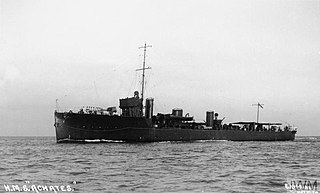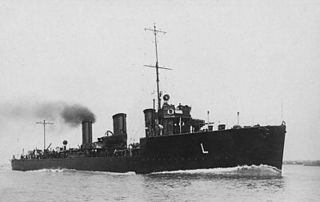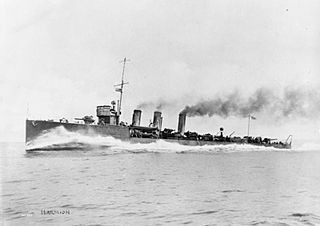HMS Owl was an Acasta-class destroyer of the Royal Navy, launched in 1913. The destroyer was part of the Grand Fleet during the First World War and took part in the Battle of Jutland. Owl survived the war and was sold for scrap in 1921.

HMS Porpoise was an Acasta-class destroyer of the Royal Navy, which was built by Thornycroft between 1912 and 1914. Porpoise served through the First World War, taking part at the Battle of Jutland in 1916, where she was damaged. In 1920, she was sold to the Brazilian Navy serving under the name Alexandrino de Alencar and was renamed Maranhão in 1927. Maranhão remained in service when Brazil entered the Second World War, being used for patrol and convoy duties. She was disposed of in 1945.
HMS Christopher was an Acasta-class destroyer of the British Royal Navy. She was built by Hawthorn Leslie in 1911–1912. She served throughout the First World War, forming part of the Grand Fleet until 1916 and taking part in the Battle of Jutland. Later in the war she served in the English Channel to protect merchant shipping against attacks by German U-boats. Christopher was sold for scrap in May 1921.

HMS Achates was an Acasta -class destroyer of the British Royal Navy. She was built by the Scottish shipbuilder John Brown and was built between 1912 and 1913. Like all Acasta-class destroyers, Achates was armed with three 4-inch (102 mm) guns and two torpedo tubes, with a specified speed of 29 knots.

HMS Laurel was a Laforey-class destroyer which served with the Royal Navy. Launched on 6 May 1913 as HMS Redgauntlet, the ship was renamed on 30 September under an Admiralty order to become one of the first alphabetical class destroyers. On commissioning, the vessel joined the 3rd Destroyer Flotilla and operated as part of the Harwich Force during the First World War. During Battle of Heligoland Bight, Laurel led a flotilla that pursued German torpedo boats, engaging with G194 and G196, and was damaged in action with the cruiser Mainz. The vessel also played a minor role in the Battles of Dogger Bank, Dover Strait and Jutland. With the cessation of hostilities, the ship was placed in reserve and scrapped on 1 November 1921.

HMS Liberty was a Laforey-class destroyer that served with the Royal Navy during the First World War. Launched on 15 September 1913 as HMS Rosalind, the ship was renamed on 30 September under an Admiralty order to become one of the first alphabetical class destroyers. On commissioning, the vessel joined the Third Destroyer Flotilla and operated as part of the Harwich Force. During Battle of Heligoland Bight, Liberty engaged with the German torpedo boats G194 and G196, and scored two hits on the cruiser Mainz. On 8 February 1917, the destroyer rammed and sank the German submarine UC-46. The vessel also played a minor role in the battles of Dogger Bank, Dover Strait and Jutland, as well as acting as a convoy escort and patrolling the Dover Barrage. With the cessation of hostilities, the ship was placed in reserve and sold to be broken up on 5 November 1921.

HMS Llewellyn was a Laforey-class destroyer that served with the Royal Navy. Laid down on 14 December 1912 as HMS Picton, the ship was renamed on 30 September 1913 under an Admiralty order to become one of the first alphabetical class destroyers, being launched on 30 October. On commissioning, the vessel joined the Third Destroyer Flotilla and operated as part of the Harwich Force during the First World War. The destroyer took part in the Battle of Heligoland Bight, as well as undertaking anti-submarine patrols and escort duties. It was during one of these patrols on 4 December 1916 that the vessel unsuccessfully attacked the German submarine UB-18. On 17 March 1917, the destroyer was struck in the bow by a torpedo launched by a German torpedo boat while rescuing survivors from the sunk destroyer Paragon, but returned to port safely by steaming backwards. With the cessation of hostilities, the ship was placed in reserve. Although subsequently offered for sale to the Finnish Navy, Llewellyn was instead withdrawn from service and sold to be broken up on 18 March 1922.

HMS Maenad was an Admiralty M-class destroyer which served with the Royal Navy during the First World War. The M class were an improvement on the previous L class, capable of higher speed. The vessel, launched in 1915, served in the Battle of Jutland in 1916, attacking both battleships and destroyers of the German High Seas Fleet. However, the vessel was notorious for undertaking a sharp manoeuvre which obstructed other destroyers in the fleet from attacking. Maenad also undertook anti-submarine patrols. In 1917, the ship mistakenly attacked the British submarine G12 thinking it was a German boat. The submarine escaped with damages. After the armistice that ended of the war, Maenad was placed in reserve until being sold to be broken up in Germany in 1921.

HMS Pelican was a Admiralty M-class destroyer which served with the Royal Navy during the First World War. The M class were an improvement on the preceding L class, capable of higher speed. Launched on 18 March 1916, the vessel served with the Grand Fleet, taking part in significant actions on 19 August 1916 and 4 May 1917, as well as the fight between the British and German battlecruisers in the Battle of Jutland. The destroyer also undertook the other more general roles were typical of the type, including anti-submarine sweeps and escort duties for convoys. The destroyer had success driving away German submarines but did not sink any. After the end of the war, Pelican initially joined a Local Defence Flotilla but within a year had been placed in reserve and was subsequently sold to be broken up on 9 May 1921.

HMS Peregrine was a Admiralty M-class destroyer that served with the Royal Navy during the First World War. The M class were an improvement on the preceding L class, capable of higher speed. Launched on 29 May 1916, the vessel served with the Grand Fleet, focusing on anti-submarine warfare. In 1917, the destroyer was involved in the search for UC-65 after the submarine had sunk the protected cruiser Ariadne. In 1918, the ship participated in one of the final sorties of the war, although this did not lead to a confrontation with the German High Seas Fleet. After the Armistice that ended the war, the destroyer was placed in reserve and subsequently sold to be broken up on 9 May 1921.

HMS Mystic was an Admiralty M-class destroyer which served with the Royal Navy during the First World War. The M class was an improvement on the previous L class, capable of higher speed. The vessel, originally named HMS Myrtle but renamed before being launched in 1915, joined the Grand Fleet as part of the Eleventh Destroyer Flotilla. The ship was assigned as part of a destroyer screen to protect the British battleships as they sought to destroy the German High Seas Fleet. During the Battle of Jutland in 1916, the destroyer saw action against German light cruisers and, as the evening fell, attacked the German battle line, but recorded no hits. During the following year, the vessel took part in a large anti-submarine patrol, but did not see any German submarines. Later in the war, the ship was transferred to the Coast of Ireland Station at Buncrana and escorted convoys at the start of their journey from ports on the Clyde and Mersey or at the end of their journey across the Atlantic Ocean. After the Armistice in 1918 that marked the end of the First World War, Mystic was placed in reserve before being decommissioned and subsequently sold to be broken up in 1921.

HMS Mons was an Admiralty M-class destroyer which served with the Royal Navy during the First World War and fought in the Battle of Jutland. The M class was an improvement on the preceding L class, capable of higher speeds. The ship, the first British naval vessel to be named after the Battle of Mons, was launched in 1915. Joining the Grand Fleet as part of the new Eleventh Destroyer Flotilla, the destroyer was soon in action, taking part in patrols that aimed to draw out the German High Seas Fleet. During the Battle of Jutland in 1916, Mons attacked the German light cruisers at the forefront of the German battleline but scored no hits. After the armistice, the destroyer was placed in reserve. Mons was found to be worn out by wartime operations and, despite only serving for six years, in 1921, was sold to be broken up.

HMS Mameluke was an Admiralty M-class destroyer which served with the Royal Navy during the First World War. The M class was an improvement on the preceding L class, capable of higher speeds. The ship, the first Royal Navy vessel to be named after the Mamelukes, a class of ex-slaves that ruled Egypt, was launched in 1915. The destroyer joined the Twelfth Destroyer Flotilla and, although under refit during the Battle of Jutland and so unable to participate, later took part in anti-submarine operations as part of this flotilla, although no submarines were sighted or sunk. The conditions of service in the North Sea meant that the destroyer was soon worn out and, after the armistice, Mameluke was placed in reserve. Despite a service life of only six years, the vessel was decommissioned and, in 1921, sold to be broken up.

HMS Napier was a Repeat Admiralty M-class destroyer which served in the Royal Navy during the First World War. The M class were an improvement on the previous L-class destroyer, capable of higher speed. The vessel was launched on 27 November 1915 and joined the Grand Fleet. Napier had a varied war career, acting as part of the destroyer screen for the First Battle Squadron during the Second Battle of Heligoland Bight and searching for the survivors of losses like the armoured cruiser HMS Hampshire. The vessel was usually based at Scapa Flow but spent a brief time seconded to the Harwich Force in 1917. After the Armistice that marked the end of the First World War, Napier was placed in reserve before being decommissioned and sold to be broken up on 8 November 1921.

HMS Oracle was a Repeat Admiralty M-class destroyer which served in the Royal Navy during the First World War. The M class were an improvement on the previous L-class, capable of higher speed. The vessel was launched on 23 December 1915 and joined the Grand Fleet. Oracle spent much of the war involved in anti-submarine warfare. In August 1916, the destroyer rescued the crew of the light cruiser Nottingham, which had been sunk by a German submarine. In August 1917, the destroyer rammed and sank the submarine U-44. After the Armistice that marked the end of the First World War, the destroyer was transferred to Portsmouth. Initially, the destroyer was part of the local defence flotilla but soon Oracle was placed in reserve, decommissioned and, on 30 October 1921, sold to be broken up.

HMS Mindful was a Admiralty M-class destroyer which served with the Royal Navy during the First World War. The M class destroyers were an improvement on the previous L-class, capable of higher speed. The vessel, launched in 1915, joined the Twelfth Destroyer Flotilla under the flotilla leader Faulknor. The ship saw action during the Battle of Jutland in May 1916 and helped sink the German torpedo boat SMS V48. In March 1917, the destroyer was involved in a friendly fire incident, nearly sinking the British submarine G12. In June that year, the vessel was involved in the sinking of the German merchant ship SS Gamma in Norwegian waters, which led to a diplomatic protest from the Norwegian government. At the end of the war, Mindful was withdrawn from service and, in 1921, sold to be broken up.

HMS Onslaught was a Admiralty M-class destroyer which served with the Royal Navy during the First World War. The M class were an improvement on the previous L-class, capable of higher speed. The vessel, launched in 1915, joined the Twelfth Destroyer Flotilla under the flotilla leader Faulknor. The ship saw action during the Battle of Jutland in May 1916, jointly sinking the German torpedo boat SMS V48 and launching the torpedo that sank the pre-dreadnought battleship Pommern, the only German battleship to be lost in the battle. Subsequently, the destroyer acted as an escort to other naval ships during the Action of 19 August 1916 and took part in anti-submarine operations. At the end of the war, Onslaught was withdrawn from service and, in 1921, sold to be broken up.

HMS Minion was an Admiralty M-class destroyer which served in the Royal Navy during the First World War. The M-class ships were an improvement on those of the preceding L class, capable of higher speed. Minion was launched in 1915 and joined the Grand Fleet. The destroyer participated in the Battle of Jutland in 1916 as part of the Eleventh Destroyer Flotilla, particularly in the evening action between the light cruisers. During an anti-submarine patrol during the following year, the destroyer ran low on fuel. An attempt was made to refuel from the light cruiser Calliope, which was unsuccessful, leading to the patrol being curtailed. In 1918, the vessel was transferred to Devonport as part of the Fourth Destroyer Flotilla. After the Armistice, Minion was sold to be broken up in 1921.

HMS Nonsuch was a Repeat Admiralty M-class destroyer that served in the Royal Navy during the First World War. The M class was an improvement on those of the preceding L class, capable of higher speed. Originally laid down as HMS Narcissus but renamed before being launched in 1915, Nonsuch joined the Twelfth Destroyer Flotilla of the Grand Fleet. During the Battle of Jutland in 1916, after being attacked by the light cruisers of the German High Seas Fleet, the warship rescued the damaged destroyer Acasta. The vessel formed part of the screen for the dreadnought battleships of the First Battle Squadron during the Second Battle of Heligoland Bight in 1917. In both actions, the destroyer reported no hits. After the Armistice that ended the war, Nonsuch was initially put in reserve and then sold in 1921 to be broken up.

HMS Contest was an Acasta-class destroyer of the British Royal Navy. She was built by Hawthorn Leslie and Company at their Newcastle upon Tyne shipyard, and was launched on 7 January 1913, being completed in June that year. Contest served in the First World War, and supported the Grand Fleet until 1916. The destroyer took part in the Battle of Jutland on 31 May/1 June 1916. Later that year, Contest moved to The Humber, and then to the English Channel for anti-submarine and escort duties. She was torpedoed and sunk by a German submarine on 18 September 1917.











